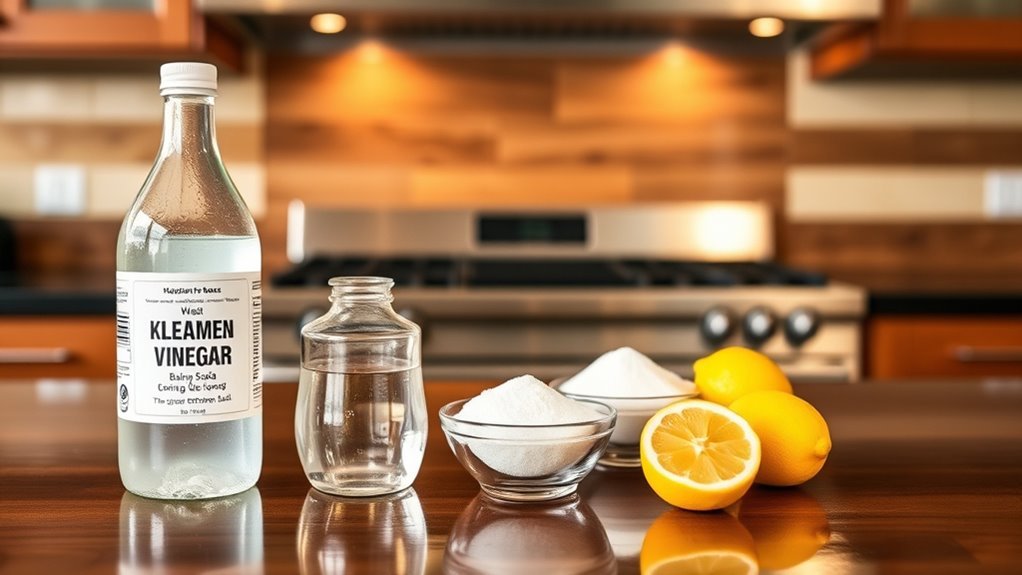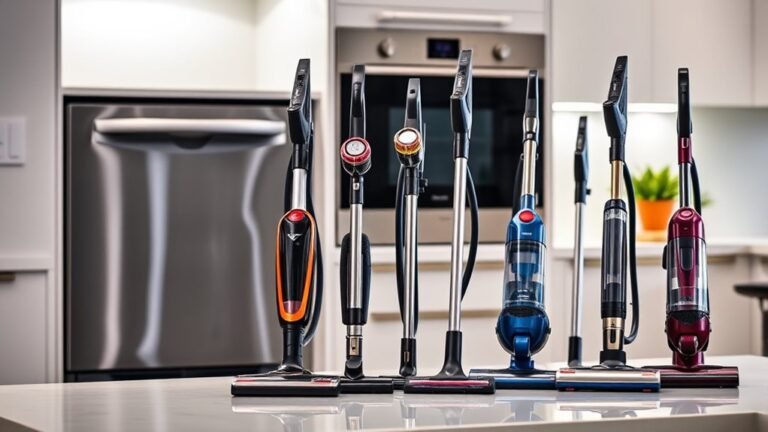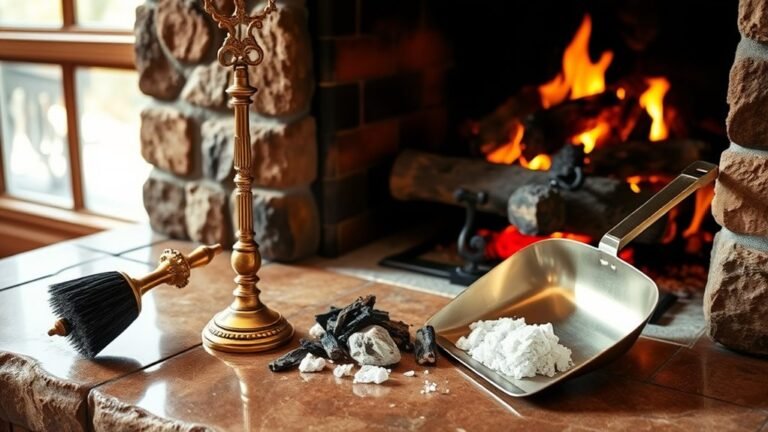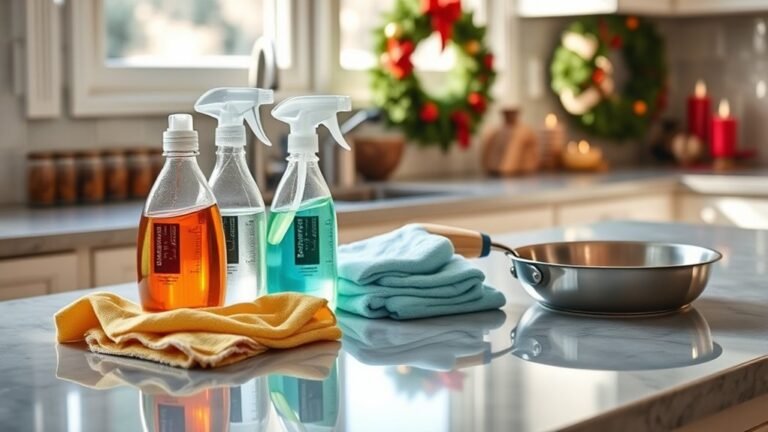How to Make Homemade Range Hood Cleaner
To make your own range hood cleaner, mix half a cup of white vinegar, a tablespoon of baking soda, and one cup of warm water. Stir gently to avoid fizzing over. You can add a little liquid dish soap for extra grease-cutting power. Spray or apply the solution with a sponge, let it sit for a few minutes, then wipe clean. This natural cleaner is safe, effective, and eco-friendly. Keep going to discover tips for stubborn grease and cleaning safety.
Understanding the Importance of Cleaning Your Range Hood
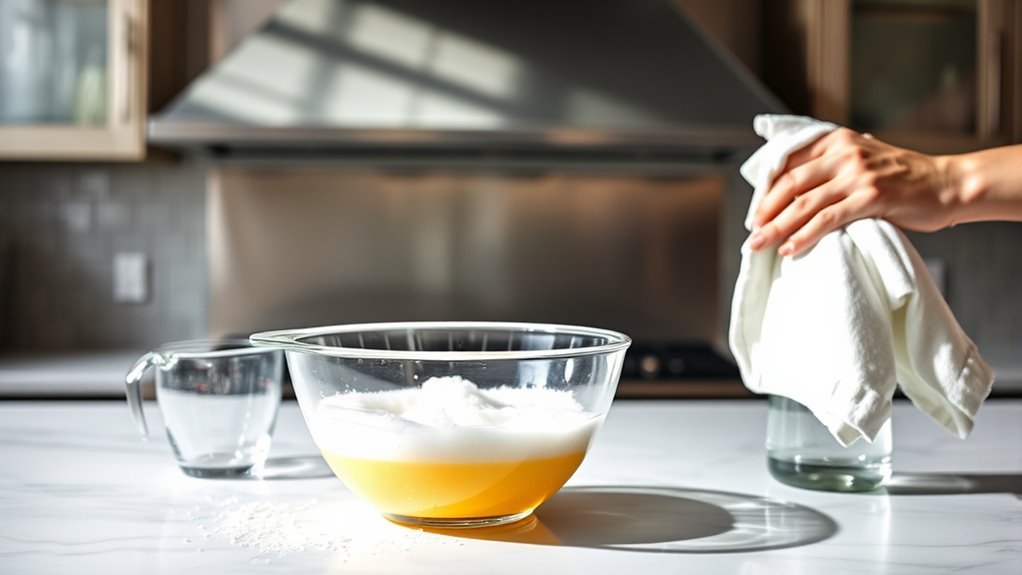
Although you might overlook it, cleaning your range hood is essential for maintaining a safe and efficient kitchen. If you want to enjoy cooking without worrying about smoke or unpleasant odors, you need to keep your range hood in top shape. Grease buildup doesn’t just affect performance—it’s a fire hazard waiting to happen. By sticking to a regular cleaning frequency, you can prevent grime from taking over and keep your kitchen air fresh. You don’t have to be stuck with complicated routines; a simple schedule tailored to your cooking habits can give you freedom from worrying about hidden dangers. Taking control of your range hood’s cleanliness guarantees safety and efficiency, letting you cook freely without unnecessary risks.
Essential Ingredients for DIY Range Hood Cleaner
You’ll want to choose natural ingredients that are both safe and effective for cleaning your range hood. Common options like vinegar, baking soda, and lemon juice work wonders without harsh chemicals. These simple items not only tackle grease but also keep your kitchen environment healthy.
Natural Cleaning Ingredients
Creating an effective DIY range hood cleaner starts with choosing the right natural ingredients. If you want natural alternatives that are eco friendly options, here are three essentials to get you started:
- White Vinegar – This powerhouse cuts through grease effortlessly and is completely natural.
- Baking Soda – A gentle abrasive that lifts grime without harsh chemicals.
- Lemon Juice – Provides natural acidity and a fresh scent, boosting cleaning power.
Safe and Effective Choices
When selecting ingredients for your DIY range hood cleaner, it’s important to focus on options that are both safe for your home and effective against grease buildup. You want homemade alternatives that won’t expose you to harsh chemicals but still deliver strong cleaning effectiveness. Ingredients like white vinegar, baking soda, and liquid castile soap are fantastic choices. Vinegar breaks down grease effortlessly, while baking soda acts as a gentle abrasive to lift grime. Castile soap helps cut through oils without leaving residue. By choosing these safe and natural components, you maintain control over what touches your surfaces and avoid toxicity. This approach not only protects your health but also guarantees your range hood stays spotless and operates efficiently, giving you the freedom to clean confidently and sustainably.
Step-by-Step Guide to Making Your Own Cleaner
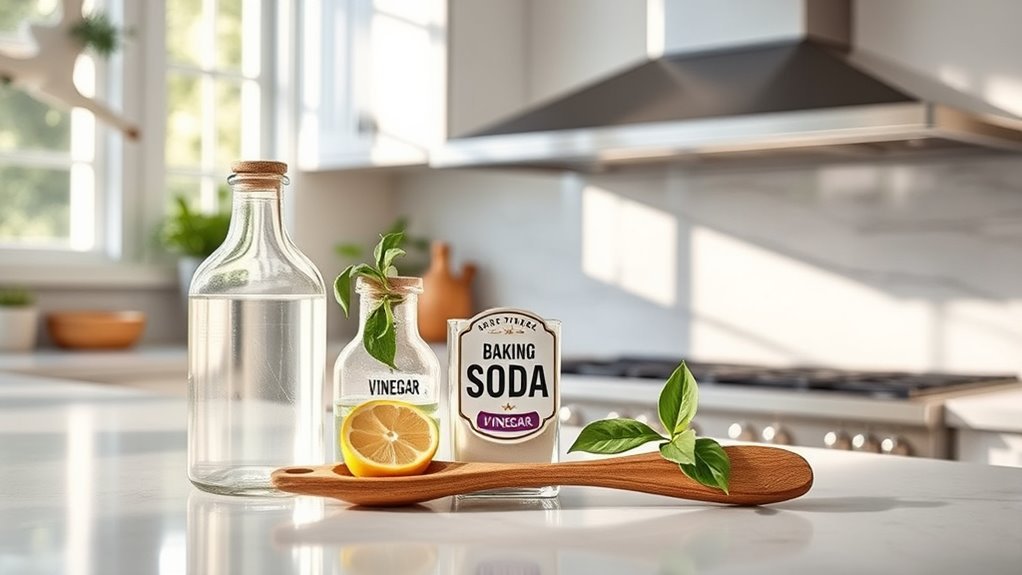
First, you’ll want to gather all the essential ingredients needed for your cleaner. Next, mix them together carefully to create an effective cleaning solution. Finally, apply the solution to your range hood and rinse it off for a spotless finish.
Gather Essential Ingredients
Essential ingredients for your homemade range hood cleaner are simple and easy to find, often already stocked in your kitchen. Keeping up with range hood maintenance doesn’t have to be complicated or costly. By gathering these essentials, you’ll be ready to tackle cleaning frequency with ease and freedom.
Here’s what you’ll need:
- White vinegar – a natural degreaser that breaks down grime without harsh chemicals.
- Baking soda – adds scrubbing power and helps neutralize odors.
- Liquid dish soap – cuts through grease effectively while keeping your solution gentle.
Having these ingredients on hand allows you to maintain your range hood effortlessly and on your own schedule. This approach not only saves money but also gives you control over the cleaning process.
Mix Cleaning Solution
Although the ingredients are simple, mixing them correctly is key to an effective homemade range hood cleaner. Start by measuring your components carefully—stick to the right solution ratios to maximize cleaning power without wasting supplies. For example, combine one cup of warm water with half a cup of white vinegar and a tablespoon of baking soda. This blend creates a potent yet safe cleaner that tackles grease and grime efficiently. Remember, understanding these cleaning methods guarantees you get the best results every time. Stir gently until the mixture is well combined, avoiding fizzing over. Once your solution is ready, you’re set to clean your range hood thoroughly and enjoy the freedom of a fresh, chemical-free kitchen environment.
Apply and Rinse
Once you’ve prepared your cleaning solution, you’ll want to apply it evenly across your range hood’s surfaces to break down grease and grime effectively. Mastering the right apply techniques guarantees every corner is covered without wasting any cleaner. Here’s how to get it done:
- Use a spray bottle or sponge to distribute the solution consistently, paying close attention to greasy spots.
- Let the solution sit for 5-10 minutes; this dwell time loosens stubborn buildup without scrubbing.
- Rinse methods matter—wipe down with a damp microfiber cloth, then rinse with warm water to remove residue and avoid streaks.
Best Techniques for Applying Homemade Cleaner
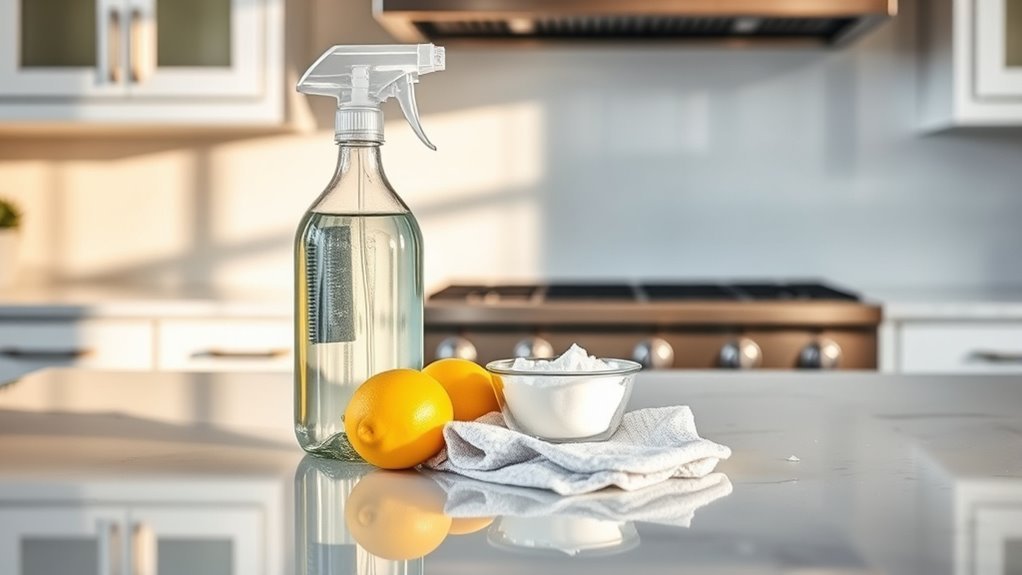
When applying your homemade range hood cleaner, you’ll want to focus on even coverage and gentle scrubbing. Start by spraying or wiping the cleaner evenly across the surface, guaranteeing no spots are missed. Use a soft cloth or sponge to avoid scratching, and apply light pressure as you work in circular motions. This approach prevents damage and lifts dirt effectively. For tight corners or vents, a small brush helps reach tricky areas without fuss. These application techniques guarantee your cleaning methods are both efficient and thorough, giving you freedom from harsh chemicals while keeping your range hood spotless. Remember, consistency in your technique is key to maintaining a fresh, grease-free kitchen environment with your homemade solution.
Tips for Removing Stubborn Grease and Grime
Anyone who’s tackled a greasy range hood knows that some spots just won’t budge with regular cleaning. To break free from stubborn build-up, you need effective grease cutting and stain lifting strategies. Here are three tips to help:
Tackling stubborn grease requires more than routine cleaning—effective stain lifting and grease cutting are key.
- Apply a paste made from baking soda and water directly on tough grease spots. Let it sit for 15 minutes to boost stain lifting power before scrubbing.
- Use vinegar spray on the range hood surface. Its natural acids aggressively cut through grease without harsh chemicals.
- Scrub with a non-abrasive brush or sponge to avoid damaging your hood while loosening grime.
Stick to these tips, and you’ll reclaim your kitchen’s freedom from stubborn grease and grime in no time.
How Often Should You Clean Your Range Hood?
How often should you clean your range hood to keep it working efficiently? Proper range hood maintenance depends on your cooking habits and the cleaning frequency. Regular upkeep prevents grease buildup, ensuring your hood operates freely and safely.
| Cooking Frequency | Recommended Cleaning Frequency |
|---|---|
| Daily cooking | Weekly |
| Occasional cooking | Monthly |
| Heavy frying/grilling | Bi-weekly |
| Rare use | Every 3 months |
If you cook greasy or fried foods often, stick to a bi-weekly or weekly cleaning schedule. For lighter use, monthly or quarterly cleaning works fine. Staying on top of cleaning frequency frees you from clogged filters and reduces fire hazards. Your range hood will thank you with better airflow and a longer lifespan.
Safety Precautions When Using Homemade Cleaners
Keeping your range hood clean on a regular schedule is a great start, but it’s also important to handle homemade cleaners with care. Homemade cleaner safety guarantees you protect yourself and your space while enjoying freedom from harsh chemicals. Here are key ingredient handling precautions to keep in mind:
- Always wear gloves and work in a well-ventilated area to avoid skin irritation and inhaling fumes.
- Store your homemade cleaner in clearly labeled containers, away from children and pets.
- Never mix ingredients like vinegar and baking soda in sealed containers, as pressure build-up can cause accidents.
Eco-Friendly Benefits of Natural Cleaning Solutions
Since natural cleaning solutions use ingredients you probably already have at home, they offer an eco-friendly alternative that reduces your environmental impact. By choosing natural alternatives, you avoid harsh chemicals that can pollute the air and water, helping you live freer from toxins. These homemade cleaners break down more easily, minimizing waste and harm to ecosystems. Plus, when you make your own cleaner, you control exactly what goes into it, giving you the freedom to protect your health and the planet. Embracing natural alternatives for your range hood cleaner isn’t just about effectiveness—it’s a small but powerful way to reduce your environmental impact and contribute to a cleaner, healthier world without sacrificing convenience or results.
Troubleshooting Common Range Hood Cleaning Issues
Even with natural cleaners, you might run into some common issues when cleaning your range hood. Don’t worry—it’s all part of the process. Here’s how to troubleshoot:
- Stubborn grease buildup: If grease won’t budge, increase your cleaning frequency. Try soaking filters in a hot vinegar and baking soda solution to break down tough grime.
- Lingering odors: Natural cleaners sometimes leave behind scents. Rinse thoroughly with water and dry completely to avoid any residual smells.
- Filter damage: Over-scrubbing can harm filters. Use gentle tools like soft brushes and avoid harsh scrubbing pads to maintain their integrity.
Frequently Asked Questions
Can Homemade Cleaners Damage My Range Hood’S Finish?
Did you know 60% of DIY cleaners can unintentionally damage surfaces? When you use homemade cleaners, you’ve got to be mindful of cleaner ingredients like vinegar or baking soda, as they might harm your range hood’s finish if it’s delicate. Checking surface compatibility is key to keeping your hood looking great while enjoying the freedom of homemade solutions. Always test a small spot first to avoid surprises!
How Do I Dispose of Used Homemade Cleaner Safely?
When you’re ready to dispose of used homemade cleaner, remember to do it with eco friendly disposal in mind. Avoid pouring it down drains or onto soil, as it might harm the environment. Instead, store leftover cleaner safely in a labeled container for future use or take it to a local hazardous waste facility. Proper cleaner storage helps you keep control and reduces waste, letting you stay free and responsible.
Are Homemade Cleaners Safe for All Range Hood Materials?
You might worry homemade cleaners could damage your range hood materials, but if you tailor your solution, you’ll maintain both safety and cleaner effectiveness. Different materials like stainless steel, aluminum, or glass react differently, so always test a small spot first. By choosing gentle ingredients and avoiding harsh chemicals, you keep your range hood looking great while enjoying the freedom of customizing your cleaner to fit your needs perfectly.
Can I Use Homemade Cleaner on Other Kitchen Appliances?
You can definitely use homemade cleaner on other kitchen appliances, but always consider the material first. Natural cleaning alternatives like vinegar and baking soda work great for kitchen appliance maintenance, offering a safe, chemical-free way to keep things sparkling. Just avoid abrasive scrubbing on delicate surfaces to prevent damage. By choosing homemade cleaners, you’re embracing freedom from harsh chemicals while maintaining your appliances effectively and responsibly.
What Should I Do if I Accidentally Ingest the Cleaner?
If you accidentally swallow that cleaner, don’t go throwing a victory parade just yet—this isn’t the kind of freedom you want to celebrate. Your first aid move should be to rinse your mouth thoroughly with water, then drink a small glass to dilute the taste. Don’t induce vomiting; that’s a trap! Next, call emergency response or poison control immediately. Freedom means smart choices, so act fast and stay safe!
